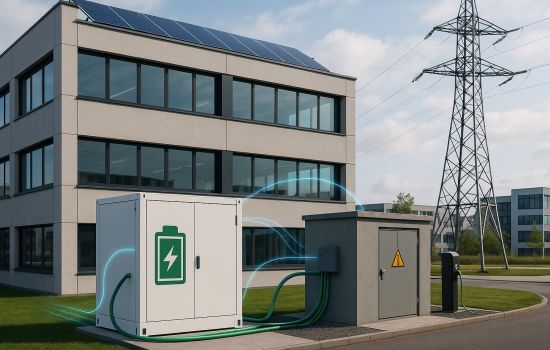Battery Revenue Models: How to Unlock Value from Flexibility
For many organizations, a battery is no longer a luxury — it’s a necessary step.
Due to grid congestion, there is often not enough capacity on the grid connection, which delays or even halts expansion plans. In such cases, a battery provides the solution. With a battery, you can prevent peaks in electricity demand and maximize the use of your self-generated solar power. This keeps the grid load within limits and reduces the amount of purchased electricity. But the true potential of a battery only becomes apparent when it is used intelligently.
When combined with the right software, solar panels, and an energy management system, multiple revenue models become possible.

We distinguish three layers of revenue (for the Dutch market):
1. Structural revenue
Reducing costs through local optimization
Even without participating in energy markets, a battery already offers structural benefits:
- By absorbing peaks locally, you can often avoid the need for an expensive grid upgrade.
- The capacity tariff decreases thanks to a flatter consumption profile.
- Self-generated energy is stored and used at times when you would otherwise need to buy power.
- Curtailment of solar energy is prevented, as surplus energy can be temporarily stored in the battery.
In one of our projects, this revenue layer resulted in annual savings of over €23,000 in grid costs. Of course, the exact impact depends on the local situation, but the principle is widely applicable.
2. Market revenue
Capitalizing on price fluctuations
A battery enables targeted responses to energy market price changes:
- On the day-ahead market, you charge cheaply and consume or sell when prices are higher.
- On the imbalance market, you can help stabilize the grid while earning financial compensation.
This doesn’t require a complex trading strategy — smart software automatically responds to price signals. In a real-life example with a 1 MWh battery, this approach generated an annual market value of €37,000. The number is project-specific, but it demonstrates the earning potential.
3. Capacity revenue through grid services
Offering flexibility to the grid
With the right configuration, a battery can also be used actively for congestion management.
You make flexibility available to the grid via a Congestion Service Provider (CSP), receiving compensation per activation or per avoided kilowatt-hour.
Through Capacity Limitation Contracts (CBCs), it’s possible to earn rewards without disrupting your operations. Control is based on agreements and software that takes your consumption patterns and comfort levels into account.
This revenue layer is especially interesting for sites with multiple assets — such as PV systems, charging stations, or heat pumps — that can be intelligently coordinated.
Explore your opportunities with the Flex-E subsidy
Would you like to explore the possibilities at your site first?
The Flex-E scheme from the Dutch government agency RVO helps organizations study how flexibility can be used to tackle grid congestion. Subsidies are available for scans, feasibility studies, and concrete implementation measures.
More information: www.rvo.nl/subsidies-financiering/flex-e
Don’t let your battery stand still
A battery that only absorbs peaks uses only part of its potential.
With smart software, predictive algorithms, and a clear strategy, that same battery can continuously create value — not only in euros, but also in continuity, future resilience, and property value.
VBoptimum supports organizations in realizing all three revenue layers.
We ensure that technology, control, and financial returns are perfectly aligned — tailored to your building or portfolio.
Curious about the revenue potential at your location?
Contact VBoptimum or request a simulation. Within just a few days, we’ll make the opportunities for your building visible — from cost savings to market value.
Smart energy starts with insight. And a battery should never stand still.

